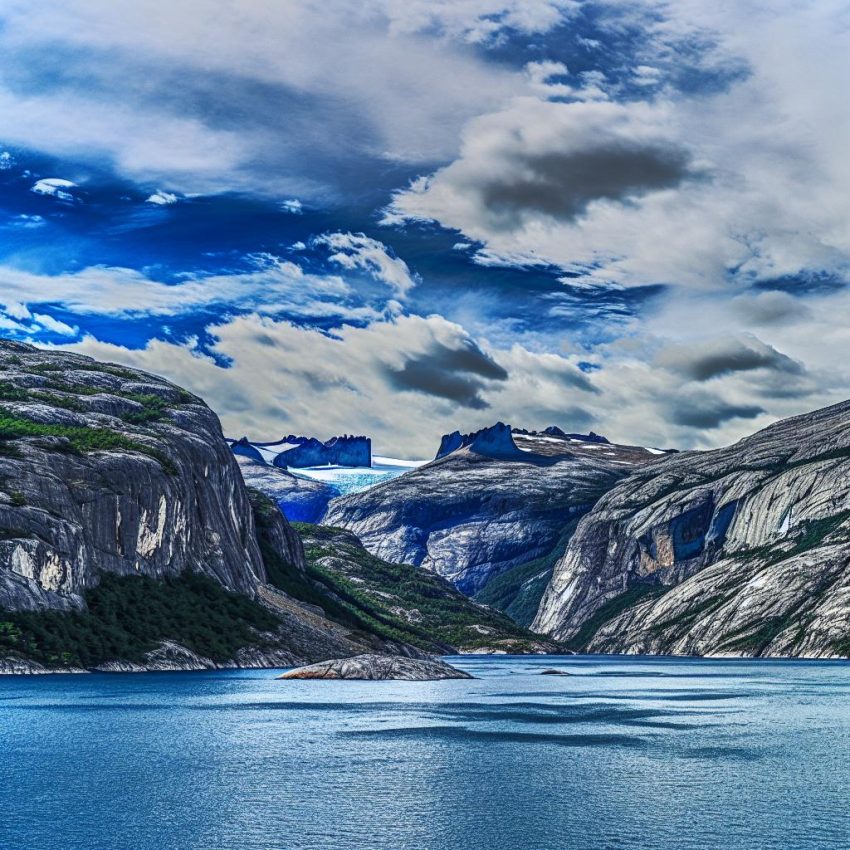Overview of the Patagonian Fjords
The Patagonian Fjords are a spectacular series of fjords located in the southern part of Chile, in the region historically known as Patagonia. This remote and rugged landscape is characterized by a complex network of channels, inlets, and islands, which were carved by glacial activity during the last Ice Age. The fjords stretch over a massive area, extending approximately 1,500 kilometers from the Reloncaví Estuary to Cape Horn. This vast area offers a diverse and fascinating ecosystem that continues to draw scientific interest and adventurous travelers from all corners of the globe.
Geological Formation
The formation of the Patagonian Fjords is primarily attributed to glacial and tectonic processes. As glaciers advanced and retreated over thousands of years, they carved deep valleys into the landscape. When these glaciers melted, seawater flooded the valleys, leading to the creation of the fjords. The entire process sculpted awe-inspiring cliffs, high mountains, steep valleys, and numerous islands scattered throughout the region. Glaciologists and geologists often study these fjords to gain insights into the ancient Earth’s climatic shifts and tectonic movements.
While glacial activity is often credited for the fjord’s formation, the contribution of tectonic plates should not be overlooked. The South American plate and the Nazca Plate’s interaction causes continued uplift and subsidence in certain areas, shaping the fjords and its picturesque backdrop. The interplay between these forces has resulted in one of the world’s most remarkable geographical sites that remain a focal point for geological explorations and studies.
Climate of the Fjords
The climate within the Patagonian Fjords is predominantly cold and wet, complemented by significant rainfall distributed throughout the year. This region experiences a temperate rainforest climate, supporting thick, luscious vegetation that thrives in the moist conditions. The yearly precipitation averts any significant dryness, ensuring that plant life flourishes continuously.
Due to the proximity of the ocean, the temperatures in the area are moderated, granting the fjords relatively mild winters and cool summers. This dynamic interplay of oceanic and atmospheric influences creates a unique environment that allows a diverse set of species to thrive. However, travelers need to be adequately prepared for the rapidly changing weather patterns, which often encompass sunshine, rain, and wind within a single day. This unpredictability necessitates that visitors stay vigilant and pack accordingly to cater to these swift shifts in climate.
Flora and Fauna
The unique environment of the Patagonian Fjords supports a diverse range of flora and fauna. Lush forests, primarily composed of southern beech trees, blanket the landscape, creating a vibrant green backdrop. These forests are habitats to various species of plants and animals. Intricately woven ecosystems sustain life even in the cold, and sometimes harsh, climatic conditions.
The fjords are home to numerous bird species, both migratory and endemic. Notably, the Andean condor and the Magellanic penguin are among the most fascinating avian residents in the area. Marine life is equally abundant, drawing nature enthusiasts and photographers eager to capture the majestic beauty of sea lions lounging, dolphins elegantly navigating the waters, and the occasional whale breaching the surface. Such biodiversity highlights the importance of conservation efforts to preserve these ecosystems for future generations.
The fjords also offer ideal conditions for marine research, with the potential for discoveries that could enhance our understanding of marine biology. Scientists frequently conduct studies in these waters to explore the intricate behaviors and interactions of marine species within their habitat.
Tourism and Accessibility
Access to the Patagonian Fjords is relatively limited owing to the remote nature of the region. Nonetheless, tourism is witnessing a gradual increase, primarily facilitated by guided boat tours and cruises traversing the fjords. These tours offer visitors the invaluable opportunity to experience the breathtaking scenery, observe wildlife in their natural habitats, and gain a deeper appreciation for the geological wonders present in the area.
For individuals seeking an adventure beyond the conventional, there are hiking trails and remote lodges that provide opportunities for a more intimate interaction with the fjords’ environment. Hikers can follow designated paths through the untouched wilderness, explore hidden waterfalls, or embark on trailblazing expeditions to uncover the lesser-known parts of this majestic region. Remote lodges offer a rustic charm and solitude, perfectly complementing the serene landscape and providing a comfortable haven after a day filled with exploration.
Local communities, stakeholders, and dedicated conservationists are continuously working towards ensuring that tourism development remains sustainable and minimally intrusive, allowing the fjords to maintain their pristine condition. This ensures that the fjords continue to captivate the hearts of visitors while preserving the natural environment for the coming generations.
For further information on visiting the Patagonian Fjords, you can explore more on Chilean tourism websites, where a wealth of resources awaits anyone eager to embark on a journey to one of Earth’s most stunning locations. From travel guides to cultural insights, these resources offer a comprehensive glimpse into the awe-inspiring world of the Patagonian Fjords, preparing any traveler for an unforgettable adventure.

